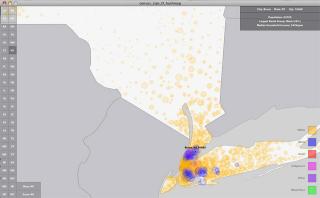Noah King
Visual ConCensus
A parametric, interactive visualization of United States Census data.
http://blog.digitalnoah.com/?cat=30

Classes
Expression Frameworks for Data: Information Visualization
Expression Frameworks for Data: Information Visualization
Using Processing and C++, US Census data is parsed, stored in data objects, and drawn to the screen. A custom interface allows users to augment the scope of the screen and adjust what they see and how they see it. This powerful tool makes a massive amount of information extremely accessible and fascinating to engage with. Users stand before a screen, interacting with the content using a mouse and / or keyboard.
Background
Growing up, my mother was a Database Administrator and frequently showed me advanced use of spreadsheet software, but I seldom found myself engaged by large datasets shown as raw data. Upon being introduced to the writings of Edward Tufte, I realized that massive amounts of information had the potential to become visually stunning artworks. My interest in creating compelling visualizations is driven by my desire to merge together two types of minds: those who are technical and mathematical, as well as those who are creative and visual.
Audience
My hope is that anyone will find this work interesting and engaging. It is intended to be very accessible, providing an entry point into the world of statistics to even a casual user. After putting 20 minutes of time into learning the nuances of the interface, a power-user would remain engaged, utilizing the software as an advanced research tool.
User Scenario
The user stands before a hi-resolution display and sees the entire US map, filled with colorful circles. A key communicates that the circles represent individual zip codes, and soon the user has zoomed in on their home state, searching for the data on their own community. A panel of configurable options lets the user manipulate the display, focusing on key factors like population density, household income, and distribution of racial groups.
Implementation
This project was divided into three phases. The first was acquiring data from the US census website. The raw data is rather unrefined, so "scrubbing" it and making other optimizations was a necessary first step. Next a script was written to parse through the data, line by line, and enter individual values into an organized structure of data objects. These objects were assigned physical properties, like diameter and color based on their numeric value, and were drawn to the screen. Finally, a user interface was designed and implemented to give users the ability to reconfigure the data based on a series of parameters.
Background
Growing up, my mother was a Database Administrator and frequently showed me advanced use of spreadsheet software, but I seldom found myself engaged by large datasets shown as raw data. Upon being introduced to the writings of Edward Tufte, I realized that massive amounts of information had the potential to become visually stunning artworks. My interest in creating compelling visualizations is driven by my desire to merge together two types of minds: those who are technical and mathematical, as well as those who are creative and visual.
Audience
My hope is that anyone will find this work interesting and engaging. It is intended to be very accessible, providing an entry point into the world of statistics to even a casual user. After putting 20 minutes of time into learning the nuances of the interface, a power-user would remain engaged, utilizing the software as an advanced research tool.
User Scenario
The user stands before a hi-resolution display and sees the entire US map, filled with colorful circles. A key communicates that the circles represent individual zip codes, and soon the user has zoomed in on their home state, searching for the data on their own community. A panel of configurable options lets the user manipulate the display, focusing on key factors like population density, household income, and distribution of racial groups.
Implementation
This project was divided into three phases. The first was acquiring data from the US census website. The raw data is rather unrefined, so "scrubbing" it and making other optimizations was a necessary first step. Next a script was written to parse through the data, line by line, and enter individual values into an organized structure of data objects. These objects were assigned physical properties, like diameter and color based on their numeric value, and were drawn to the screen. Finally, a user interface was designed and implemented to give users the ability to reconfigure the data based on a series of parameters.

